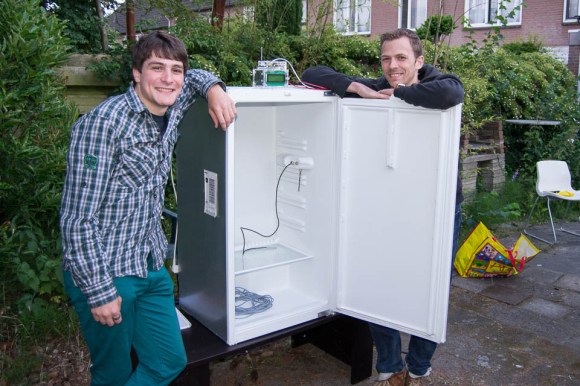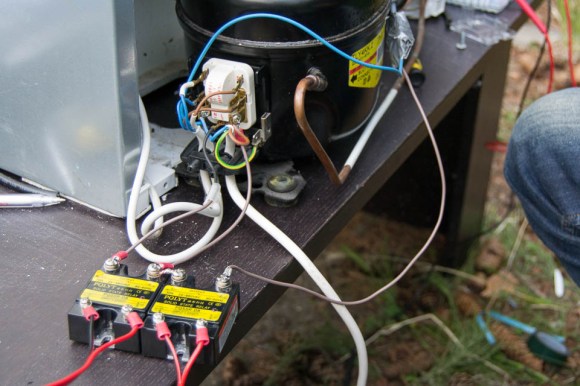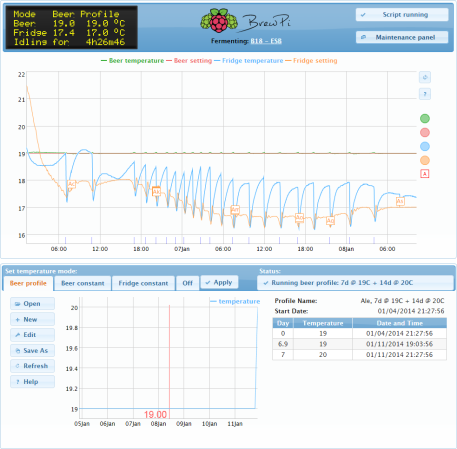
The team behind BrewPi are at it again! This time they have created an online guide showing how to convert a min-fridge into a Raspberry Pi & Arduino controlled fermentation chamber. In it, they describe 3 possible options:
- Option 1: Make a simple switched power cord, without hacking into the fridge electronics.
- Option 2: Make a switched power cord, but also override or remove the thermostat.
- Option 3: Rip out the thermostat and fully integrate the SSRs into your fridge (which is what [Koen] and [Elco] did).
First things first though. They had to clean the fridge. And depending on where they got it or how long it has been unplugged for, the inside might have been pretty rank and disgusting from mold growing out of every corner. This took a good hour or so to clean properly lest the brewing process get infected with external grossness. This is all worth it because a well-controlled fermentation chamber results in a superior batch of beer.
They put their laser cut case on top of the fridge, holding an LCD, Raspberry Pi, Arduino and the BrewPi Arduino shield. The Arduino reads the temperature sensors inside the fridge, the beer and the ambient temperature. Then it controls the SSRs they added to switch the compressor and a heater. Then, the cables were routed through the fridge and take control of the compressor.

[Elco] and [Koen] added two SSRs: one to switch AC power to the compressor and start relay, the other to power to a heater inside the fridge. But, they did need to gain access to the compressor and make a few changes. For one, the two SSR’s will be added with one of the AC terminals connected to LIVE (brown) and the other to the heater and the compressor.
No matter which method is chosen though, the end product will allow anyone to monitor and easily control the temperature range of your micro-brew, along with being able to log data and produce web-embedded graphs like the one shown below. It works by using the Arduino attached to run the temperature control algorithm autonomously, reporting to the Raspberry Pi for its web interface and data logging.
















But if you just put a temperature sensor in the fridge, you are actually only measuring the air temperature… Fridge manufacturers recommend you to put a temperature sensor in a glass of water, otherwise you won’t get a reliable measurement
Or in the wort itself – but you have to be careful as it’s very easy to overshoot with a large volume such as 5 gallons. In my system, which is Pi based as well, I have one sensor read the fridge air and one read the wort. The program then only allows a maximum difference between wort and fridge and you get a very stable temperature.
Also, I would really, really, advise using SSRs in this case – a simple mechanical relay would be cheaper and much safer – SSRs can overheat quite easily and tend to fail in the “open” position.
*advise against SSRs
Elco here. That is exactly what BrewPi does: it cools and heats the fridge air temperature, but the air temperature setting is calculated from what the beer needs. Because the actuators are coupled to the air temperature and not the beer directly, the beer temperature is very smooth.
The SSRs are 10A, which is way above what a fridge needs. They do not even get warm the slightest. A good SSR will have a longer life span than a mechanical relay, will be silent and switch on a zero crossing, so there are no high inrush currents or sparking.
I do advise against using the very cheap Fotek relays.
PS I have asked hackaday to correct some errors in this post. Among others: the pi is used for web interface and data logging, not stability. The Arduino runs the temp control standalone.
Just to add on what I said previously – I accept that your points on SSRs, and they are very useful devices in Homebrew, especially for modulating heating elements in an electronic boil kettle/hot liquor tun etc.
But where simple on/off switching is required, with large cycle times in the order of minutes, once every hour or so, they are entirely superfluous. To avoid cheap/knockoff SSRs,as you rightly point out, you typically would pay at least £30 ($50) for an SSR. My genuine 30A omron mechanical relay cost £3.50 and has an minimum life of 10,000,000 operations. Even if your fridge is switching every minute, that’s 19 years of operation, minimum. Is an SSR going to last that long ? The fridge isn’t even going to last that long.
In the worst case scenario that there is a failure, the relay will almost certainly fail leaving the power off. £3.50 later, you are back in action. As I already mentioned, SSRs can fail and leave the power on. If this project was based on a freezer, which many are to get a “chest” type configuration, that leads to frozen wort and an exploded glass carboy! or if you’ve been lucky, another £30 bill …
There is a real tendancy in the hobby community to completely overspec things like this, and it can be detrimental in some cases like this!
Zero crossing switching would not reduce inrush to an *inductive* load. That’s probably about the worse you can do.
http://www.te.com/commerce/DocumentDelivery/DDEController?Action=srchrtrv&DocNm=13C3206_AppNote&DocType=CS&DocLang=EN
“Beware of Zero-Crossover Switching of Transformers”
>A zero-crossover solid-state relay may be the worst possible method of
switching on a transformer or a highly inductive load. Evidence 1 has
come to light that zero-crossover turn-on of such loads can cause a surge
current of perhaps 10 to 40 times the steady state current, whereas
turn-on at peak voltage results in little or no surge.
Note: TE was formally know as Tyco Electric. I would take the advice seriously.
^Tyco Electronics
I had no idea. Thanks for the knowledge.
If you are planning to run one of these in continuous operation you should pay attention to power consumption — mini-fridges typically consume as much power as full-size units.
This is actually a normal sized European fridge. I guess it’s just mini by US standards.
A general note for anyone who goes “dumpster diving” to get a fridge of this type:
If it dosn’t work, the most likely cause is a PTC resistor on the compressor motor.
It’s usualy mounted in a plastic box on the compressor housing.
This is a disk the size of a quarter or euro, that heats up and turns off the starter winding of the compressor motor.
After a while, due to mechanical stresses, it breaks, or the contact surfaces arc off and the compressor will no longer work – replace it and in most cases the fridge will start working again.
I’ve revived both a small bar and a larger fridge this way.
As a point of interest, that is not a mini fridge, but a regular sized fridge.
An American-style fridge (as it’s known) is much larger, and a mini-fridge is about half the size pictured.
Just to let you know your perceptions are rather warped in the US ;-)
Another point of interest is that domestic fridges were invented by Americans which would make the larger fridge the standard and EU perceptions to be warped. :D
brewpi.com not responding
try hosting from your own home connection and pc.
you may need to listen some odd port like 81 as 80 is blocked or monitored by isp for server on residential line.
isnt making moonshine illegal? if so you may want to check with the law if you want to keep it legal.
it is the shelves that are the tubing in some freezers.
if you know refrigeration you can recover the charge from the freezer and bypass the shelves .
unfortunately the shelves are steel not copper so you cant easily weld the tubing to make bypass.
aluminum is even more difficult to weld since it can burn up easily.
if you are in wisconsin it is even more difficult to do refrigeration since the laws make you have to have a license to handle the charge although you may be able to get the connecting taps and jerry rig something to use the air horn or can of air since they use r134a witch is used in today’s refrigerators.
the heater could be eliminated by using a reversal valve for a heat pump
again if you know refrigeration you could modify the refrigerator.
in addition to the ptc switch not being ready you may have problems with the pressure as the compressor will not start.
if you are lucky and get a freezer with refrigeration based defroster you can use the diverter valve to relieve the pressure to allow restsrting the compressor otherwise you would have to have one installed.
As far as I can see the website is up and running (it runs from a dedicated server in a data center and should have problems with the load).
This is not moonshine, but brewing beer. Perfectly legal.
Yes, most freezers will not be suitable due to the coolant running through in the shelves. I address that in the article. Only chest freezers are suitable. I would not go into diverting coolant lines.
correction: server should have *no* problems
For my fermentation chamber build, I bought one of these:
http://www.amazon.com/gp/product/B000E7NYY8/ref=wms_ohs_product?ie=UTF8&psc=1
I extended the temp sensor (the nub sticking out the top) with a couple of wires, and ran it inside the back of the mini-fridge. I put the sensor inside a glass of water next to my corny keg fermenter, and set the temp.
$35 and an hour of work and it works great.
This is a great project – several of our students do things like this. Whichever control method you use (SSR or relay/contactor), be sure to build in a time delay (a couple of minutes will do) so that in the event of a power interruption or other fault the compressor doesn’t start up too soon after the previous cycle.
If you modify the evaporator by replacing the standard finned assembly with a coil of stainless tubing that can be immersed in the wort you will increase efficiency and resolve the issues of air vs wort temperature differences. This mod will require evacuation and repressurisation of the refrigerant, but should be well worth the effort.
Hello,
I have a Magic Chef Beverage Cooler with built in temp controller. I would like to change the thermostat to a temp probe to place in the fermenter, how easy is this?